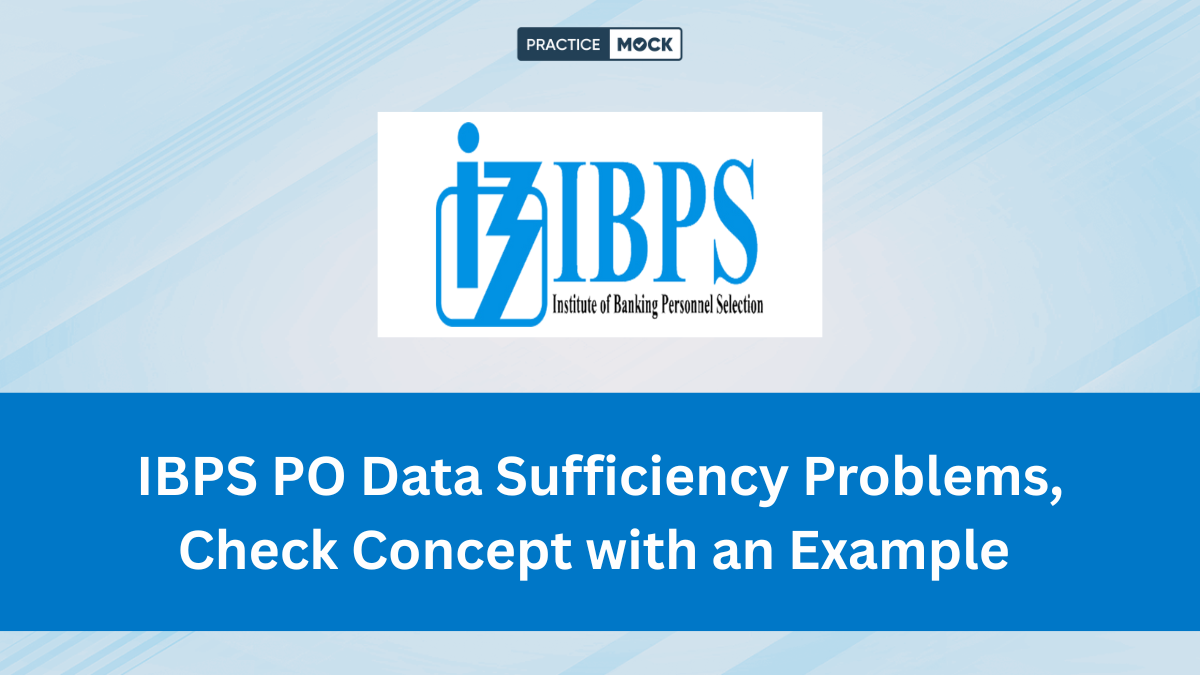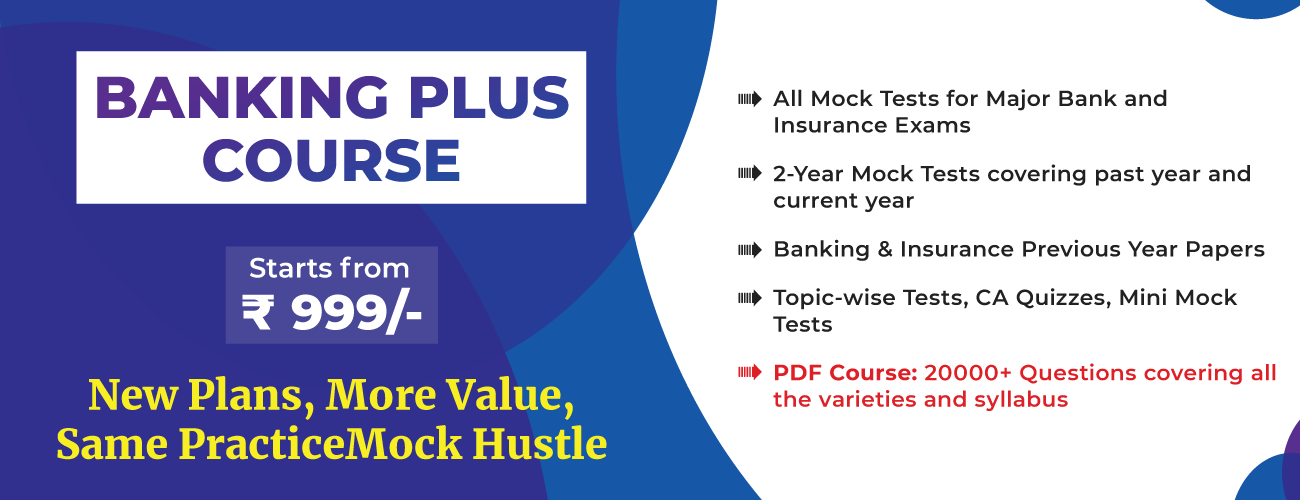The IBPS PO exam is now around the corner, and mastering important topics from each section becomes essential. The Reasoning section and the Quantitative Aptitude section in the IBPS PO Prelims and Mains have Data Sufficiency questions. Questions from this topic are asked every year in the IBPS PO exam. To excel in data sufficiency, you must have to clear your basic concepts first. It requires a basic understanding of the given data, and you need to choose conclusions that are enough to answer the given question. Make the best use of the given resources, like mock tests and topic tests, to analyse your performance in this topic. Continue reading below to know the basic concepts of data sufficiency problems asked in the IBPS PO exam.
What is Data Sufficiency?
Data Sufficiency tests your ability to decide whether the given data is enough to answer a question. It is not asked to solve the question completely. It appears mainly in the Reasoning and Quantitative Aptitude sections of IBPS PO Prelims and Mains exams. Let’s understand what are data sufficiency questions with an example given below:
Example:
Question:
What is the value of x?
Statement I: 2x+3=112x + 3 = 112x+3=11
Statement II: x2=16x^2 = 16×2=16
(A) Statement I alone is sufficient, but Statement II alone is not.
(B) Statement II alone is sufficient, but Statement I alone is not.
(C) Both statements I and II together are sufficient, but neither alone is sufficient.
(D) Each statement alone is sufficient.
(E) Statements I and II together are not sufficient.
Solution:
From Statement I:
2x+3=11 ⇒ 2x=8 ⇒ x=4
So, Statement I alone is sufficient.
From Statement II:
x^2=16⇒x=±4
So, Statement II gives two possible values → Not sufficient alone.
Answer: (A) Statement I alone is sufficient, but Statement II alone is not.
Data Sufficiency Basic Concept for IBPS PO Exam
In the IBPS PO exam, Data Sufficiency questions are asked to assess your logical reasoning and analytical ability. These questions appear in both Quantitative Aptitude and Reasoning Ability sections, especially in the Mains exam. In the Prelims exam, data sufficiency questions appear rarely and are mostly asked in the mains exam.
In Data Sufficiency, you’re given:
- A question
- Two or more statements (usually 2 or 3)
Your task is not to solve the question completely, but to check:
- Whether the information in the statements is sufficient to answer the question.
Common Answer Choices for Data Sufficiency Questions are Provided Below:
(A) Statement I alone is sufficient, but Statement II alone is not.
(B) Statement II alone is sufficient, but Statement I alone is not.
(C) Both statements I and II together are sufficient, but neither alone is sufficient.
(D) Each statement alone is sufficient.
(E) Statements I and II together are not sufficient.
Types of Data Sufficiency Questions Asked in the IBPS PO Exam
The most common types of data sufficiency problems like quantitative aptitude-based problems, reasoning-based problems, puzzle-based, comparison or ranking-based, syllogism-based, and data-interpretation-based. These types of data sufficiency questions are discussed below with an example.
Type 1: Quantitative-Based Data Sufficiency
These questions involve numerical problems from various math topics.
Common Topics:
- Arithmetic (Ages, Percentages, Ratios, Time-Speed-Distance, Time & Work)
- Algebra (Equations)
- Number Series
- Geometry & Mensuration
- Averages, Profit & Loss, SI & CI
Example:
What is the value of x?
Statement I: 2x+3=112x + 3 = 112x+3=11
Statement II: x2=16x^2 = 16×2=16
Data Interpretation-Based Data Sufficiency (Occasionally in Mains)
Instead of typical DI, you’re asked whether given info is enough to calculate values from tabular, bar, or pie chart data.
Example:
What is the profit percentage of Company A in 2023?
Statement I: Revenue of Company A is ₹50 lakhs.
Statement II: Profit earned is ₹10 lakhs.
Type 2: Reasoning-Based Data Sufficiency (Mostly Asked in Mains)
These are based on logical reasoning problems, and test your understanding of relationships, arrangements, and logic.
Common Topics:
- Blood Relations
- Direction Sense
- Coding-Decoding
- Syllogisms
- Puzzles (linear, circular, floor-based, box-based)
- Ranking and Ordering
Example:
How is P related to Q?
Statement I: P is the son of R, who is the mother of Q.
Statement II: Q is the sister of T, and P is the brother of T.
Puzzle-Based Data Sufficiency
These involve determining sufficiency to solve complex arrangements or puzzles.
Common Types:
- Seating Arrangements
- Scheduling Puzzles
- Floor-Based or Box-Based Arrangements
Comparison or Ranking-Based Data Sufficiency
These questions test your ability to determine position or rank using given clues.
Syllogism-Based Data Sufficiency
You’re asked if the conclusion(s) follow logically from the given statements.
Data Sufficiency Weightage in IBPS PO Exam
The data sufficiency is one of the most asked topics in the IBPS PO Mains exam. And they are also asked in the IBPS PO Prelims exam sometimes. Therefore, preparing for this topic becomes essential.
- Combined total: Around 10–12 Data Sufficiency questions in IBPS PO Mains.
- In Reasoning, they are often puzzle- or logic-based (e.g., seating, blood relations, directions).
- In Quant, they test your knowledge of basic math but focus on sufficiency, not full solving.
The weightage of Data Sufficiency in the IBPS PO Exam is provided below:
| Exam Stage | Section | Expected No. of Questions | Difficulty Level | Remarks |
|---|---|---|---|---|
| IBPS PO Prelims | Reasoning / Quant (rare) | 0–2 (if any) | Moderate | Very rare or merged with puzzles |
| IBPS PO Mains | Reasoning Ability | 5–7 questions | Moderate to High | May involve puzzles, seating, directions, ranking |
| Quantitative Aptitude | 4–6 questions | Moderate to High | Based on arithmetic/algebra concepts |
Tips to Solve the Data Sufficiency Question Effectively
Follow the basic tips listed below to answer the Data Sufficiency question accurately:
Tip 1: Don’t solve completely unless needed.
Tip 2: Always check what is being asked (e.g., value, relation, etc.).
Tip 3: Use elimination — rule out statements that lead to multiple answers.
Tip 4: Try checking each statement independently first.
Tip 5: If you cannot reach the answer with an individual statement, try solving with combination of both statements.
Click the link below to join our exclusive Telegram group for expert guidance, real-time doubt clearing, and personalized tips to boost your banking exam prep.

IBPS PO Data Sufficiency Problems: FAQs
It can be, if you try to solve the full question. Instead, focus only on checking whether the statements contain enough info.
To solve data sufficiency questions quickly, read the entire question carefully before attempting it. Be careful of the information given in the question and avoid making any assumptions. Both statements must be carefully read, and then a conclusion. Avoid any kind of confusion and answer the question.
The data sufficiency example questions of each type are given here in this blog. Try to solve them yourself and answer them based on the given concept.
- Sign Up on Practicemock for Updated Current Affairs, Topic Tests and Mini Mocks
- Sign Up Here to Download Free Study Material
Free Mock Tests for the Upcoming Exams
- IBPS PO Free Mock Test
- RBI Grade B Free Mock Test
- IBPS SO Free Mock Test
- NABARD Grade A Free Mock Test
- SSC CGL Free Mock Test
- IBPS Clerk Free Mock Test
- IBPS RRB PO Free Mock Test
- IBPS RRB Clerk Free Mock Test
- RRB NTPC Free Mock Test
- SSC MTS Free Mock Test
- SSC Strenographer Free Mock Test
- GATE Mechanical Free Mock Test
- GATE Civil Free Mock Test
- RRB ALP Free Mock Test
- SSC CPO Free Mock Test
- AFCAT Free Mock Test
- SEBI Grade A Free Mock Test
- IFSCA Grade A Free Mock Test
- RRB JE Free Mock Test
- Free Banking Live Test
- Free SSC Live Test




